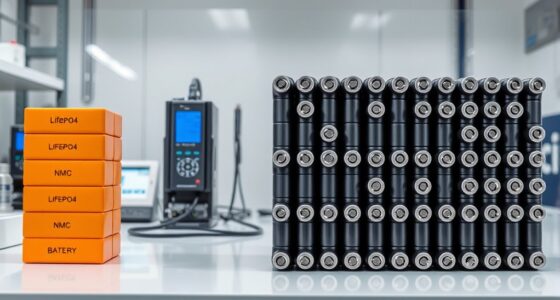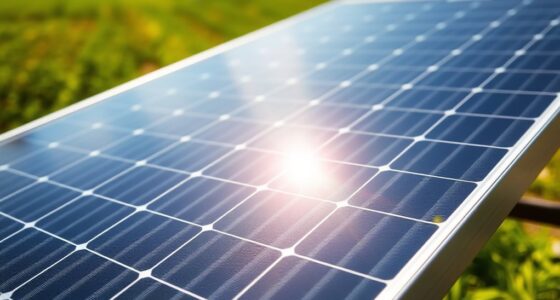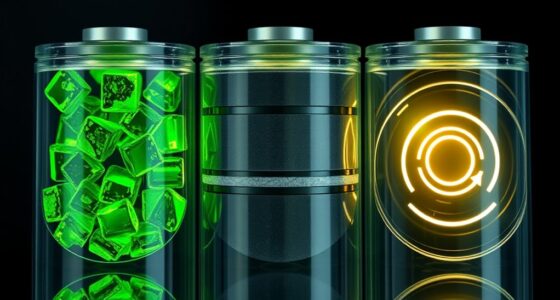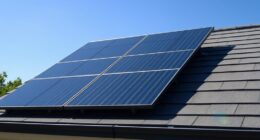Transparent solar panels are revolutionizing windows and facades by seamlessly blending into building designs without sacrificing aesthetics or natural light. They generate electricity while maintaining a sleek, modern look, allowing you to turn everyday surfaces into power sources. Made from durable materials resistant to environmental stresses, these panels are practical and long-lasting for both residential and commercial projects. As technology advances, you’ll discover how they’re shaping smarter, energy-efficient buildings—exploring what makes them a game-changer.
Key Takeaways
- Seamless integration allows solar panels to blend into windows and facades, maintaining aesthetic appeal while generating electricity.
- Advanced materials ensure durability against environmental stresses, making them suitable for high-rise buildings and harsh climates.
- They enable natural light transmission, eliminating bulky panels and expanding architectural design possibilities.
- Long-lasting, low-maintenance construction offers cost-effective energy solutions for both commercial and residential buildings.
- Continuous technological advancements enhance transparency, efficiency, and resilience, positioning them as a practical, future-ready energy source.

Have you ever wondered if solar panels could be both functional and unobtrusive? Today’s technology makes that possible with transparent solar panels, which are designed to blend seamlessly into windows and building facades. These panels aren’t just about energy generation—they also serve as part of the building’s aesthetic, transforming everyday surfaces into power sources. When considering building integration, transparent solar panels excel because they can be embedded directly into glass structures without compromising design or functionality. This means you can enjoy natural light while generating electricity, all without bulky or unsightly panels disrupting the building’s visual appeal. Their ability to seamlessly integrate into existing architecture opens up new design possibilities, allowing architects and developers to create energy-efficient buildings that look as sleek and modern as ever.
Material durability is a critical factor in the success of transparent solar panels, and advancements in this area are impressive. Unlike traditional solar panels, which are often bulky and fragile, these innovative panels are made from durable materials engineered to withstand environmental stresses. Rain, wind, hail, and temperature fluctuations no longer pose significant threats. You’ll find that the materials used in these panels resist cracking, fading, and degradation over time, ensuring long-term performance. This durability means less maintenance and replacement, making them a practical investment for both commercial and residential projects. Plus, because they are built to last, they can be incorporated into high-rise facades and large windows without concern about damage or deterioration, even in harsh climates. Additionally, recent research shows that ongoing improvements in material science are enhancing the material durability of these panels, making them even more resilient.
The combination of building integration and material durability means that transparent solar panels aren’t just a futuristic concept—they’re becoming a viable solution today. They can be integrated into a variety of building types, from skyscrapers to homes, without compromising safety or appearance. You won’t have to worry about sacrificing energy production for aesthetics; these panels deliver on both fronts. As the technology continues to evolve, expect even more robust materials that enhance durability while maintaining transparency and efficiency. Their ability to withstand the elements while remaining visually unobtrusive makes them an attractive option for sustainable architecture. Overall, transparent solar panels represent a smart, stylish, and durable approach to harnessing solar energy, transforming windows and facades into functional, energy-producing surfaces that seamlessly blend into modern design.
Frequently Asked Questions
What Is the Average Lifespan of Transparent Solar Panels?
You can expect transparent solar panels to last around 15 to 20 years, depending on their panel durability and degradation rate. As they age, their efficiency slowly decreases, but high-quality panels maintain performance longer. Proper installation and maintenance help extend their lifespan. Keep in mind that advancements in materials are continually improving durability, so future panels might last even longer, making them a reliable choice for sustainable building design.
How Do Transparent Solar Panels Affect Building Insulation?
Like the sturdy shield of a knight’s armor, transparent solar panels protect your building’s thermal insulation. They allow light to pass through while reducing heat transfer, and enhancing energy efficiency. By maintaining better temperature control, they help lower heating and cooling costs. You’ll find that these panels not only serve as windows but also work actively to improve your building’s overall insulation, making it more sustainable and cost-effective.
Are There Any Health Risks Associated With Transparent Solar Panel Materials?
You might wonder if transparent solar panel materials pose health concerns. Generally, these panels are designed with safety in mind, using materials that are non-toxic and stable. While research is ongoing, current evidence suggests minimal health risks when properly manufactured and maintained. Always choose reputable products, guarantee proper installation, and follow safety guidelines to minimize any potential material safety issues.
What Are the Maintenance Requirements for Transparent Solar Panels?
You should regularly follow cleaning routines to keep your transparent solar panels efficient, using gentle methods like soft cloths or mild cleaning solutions to avoid damage. Check their material durability over time, especially after harsh weather, and address any scratches or cracks promptly. Keeping the panels clean and well-maintained ensures maximum energy production and longevity, making them a smart, sustainable choice for your windows and facades.
How Do Transparent Solar Panels Perform in Extreme Weather Conditions?
You’ll find that transparent solar panels are designed with weather resilience and panel durability in mind, allowing them to perform well during extreme weather conditions. They resist damage from rain, snow, and wind, maintaining efficiency even in harsh environments. Their robust construction ensures they stay functional and durable, providing reliable energy generation regardless of weather challenges. So, you can trust them to withstand tough conditions while continuing to operate effectively.
Conclusion
Imagine a world where your windows and facades harness the sun’s energy, turning sunlight into power while still letting light flow through. Transparent solar panels make this vision a reality, blending innovation with everyday life. They transform ordinary surfaces into sustainable sources, offering beauty, efficiency, and environmental benefits all at once. As you walk by, see the potential—light as a resource, energy as a promise, and the future as bright as the panels themselves.









